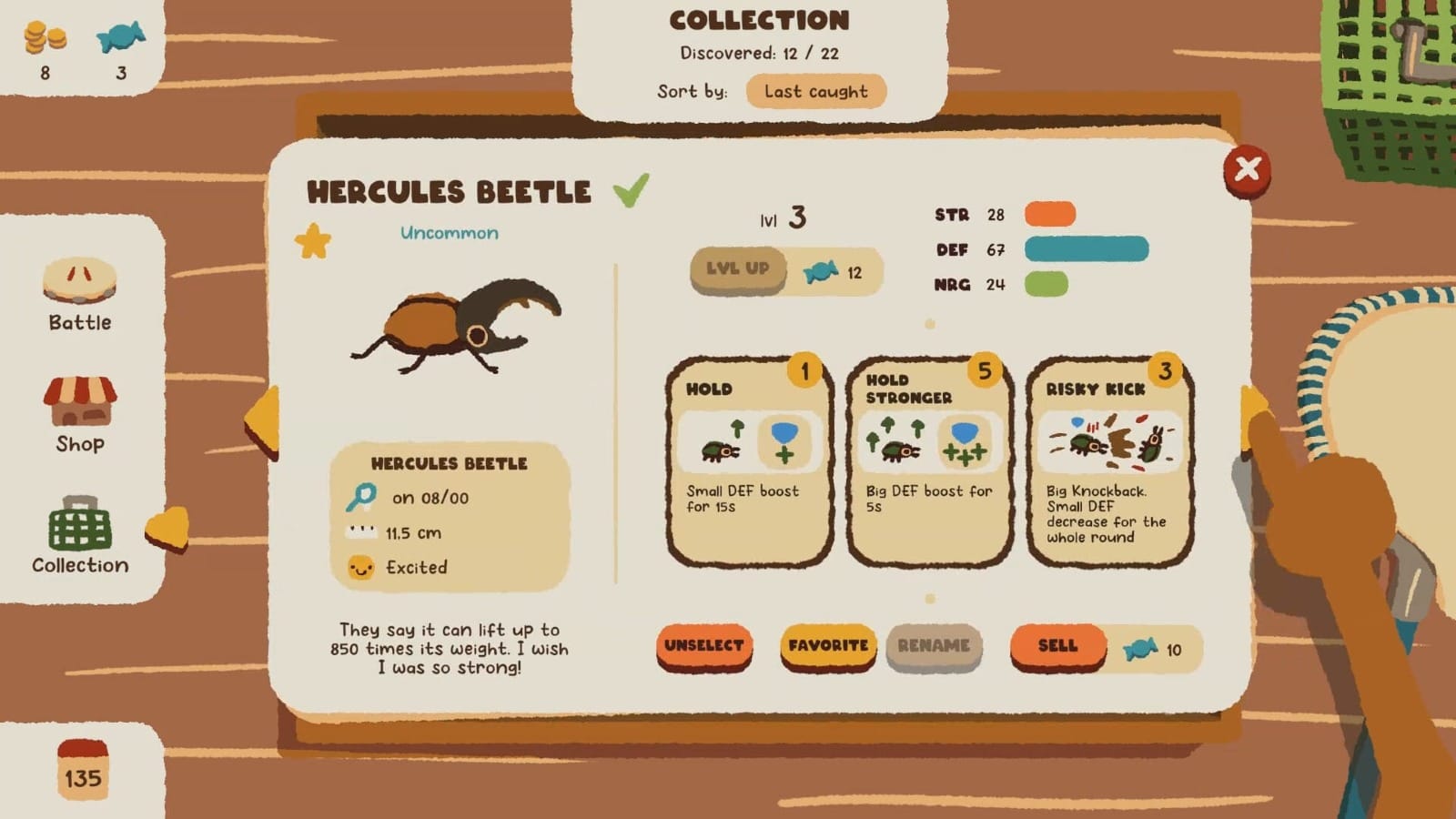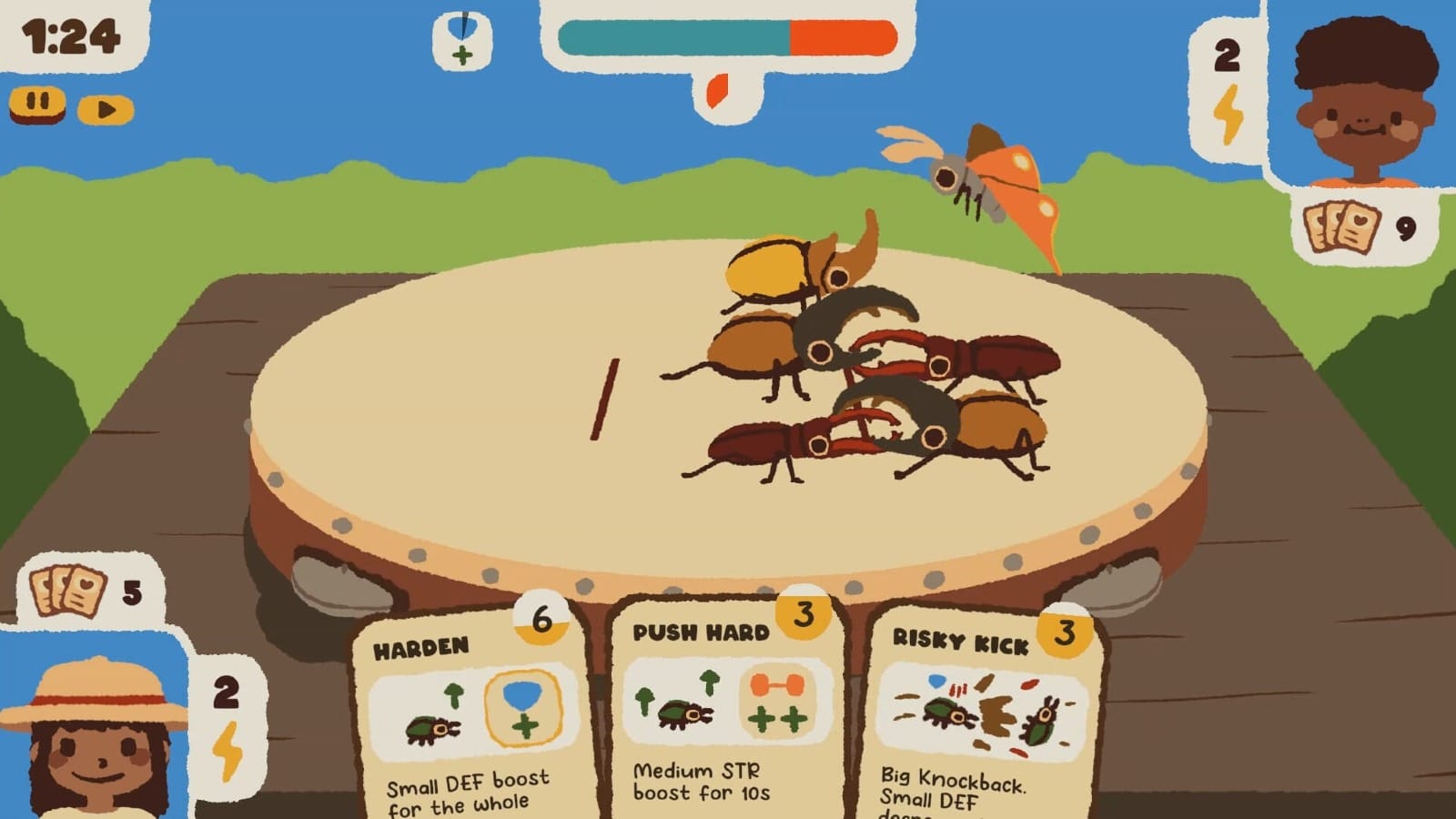
It’s a special kind of feeling when you watch the beginning and end of a creator’s journey, and I’m not talking about watching the behind-the-scenes footage of making God of War Ragnarök. I mean randomly seeing a creator promote a game they’re working on, deciding to follow them, seeing them make the title screen, and piecing everything together to then play the game on day one. It’s no secret I cherish indie games, and Kabuto Park was selfishly my little gem that I immediately knew I wanted to play and review.
You play as Hana, a kid who’s so madly obsessed with collecting bugs that she decides to go to a holiday park dedicated to catching them over the summer break. The vibes and art style of the game are incredibly charming and have that cartoonish feel, pulled straight out of a children’s storybook. This encompasses the locations you visit, the other kids you meet, and even the bugs you catch — they are so cute that I immediately imagined sticker versions of them on Etsy.

Kabuto Park doesn’t throw tons of exposition at you when you boot up the game; you know what you’re here to do, so here are your tools, and good luck! A fellow bug enthusiast, Midori, shows you the basics of catching and other features, such as using the shop and the battle system, but from there it’s all you.
The game is separated into 4 locations: Calm Lake, Crawler Swamp, Pine Forest, and Sunny Farm. All single frames have interactable points where you can discover one of many bugs. Each area has a catalog of bugs that are unique to the area, and delightfully, they align with the habitats the bugs would actually live in. You begin each area with a checklist of 5 or so bugs, each with their own rarity. You have your common, uncommon, and rare, signified by a grey, blue, and gold—respectively—sparkle when you choose a spot to look at. However, one of Kabuto Park’s features that doesn’t let monotony set in is that as August progresses, more bugs will start appearing. Therefore, once you’ve caught them all, you can look forward to revisiting the area in a few days’ time.

To catch bugs is a simple task; when you find one, a bar pops up, and you’ll be aiming to hit click when your bar is within the green area. If it hits the red, you lose the bug, and if you hit the blue you step closer, changing the layout of the bar, making it easier to catch. Kabuto Park has some difficulty settings that offer challenges in how small of a window you have in hitting the green areas. It’s more of an annoyance than a challenge, though.
Once you have caught these bugs, you get a pop-up that gives you a quick biography, from their name to statistics like their size and… move set? Yes, the second part of Kabuto Park’s gameplay is its mini sumo-style battle system where you take a team of three bugs and face the local kids to soar up the ranks to become sumo bug master! Bugs have three stats: strength, defense, and NRG (energy); each bug type will have an affinity for one of them. For example, butterflies will have more energy, and beetles will have better defense; it’s logical. Then they each have three moves that they bring to the battle.

To make your bugs more powerful, Kabuto Park uses a candy system, where if you sell duplicate bugs, you gain candies, and then those candies can be used to level up your bugs. It’s pretty simple, and for every escalating level, you have to spend candies. To match this, the rarer the bug you find, the more candies it will sell for. Candies can also be bought in the shop, which also stocks an array of items like a net that improves your bug catching, an encyclopedia that raises the chance of finding rarer bugs, and honey that forces the catching bar to slow down to make it easier to catch bugs. They all cost money, which you earn from daily battles.
To progress the summer (and your game), you need to take part in and beat daily battles against other kids’ teams of bugs. This increases your rank so you can discover more areas and receive more money to get better equipment. The battles themselves are tests of strength, like a sumo match, where your goal is to force the opponent’s team off the end of the ring. Moves have costs, and you gain energy points in real time, so the higher the cost the longer you’ll be without defense and attacks. Each side has about 5 seconds of push time, so make sure to use knockbacks in your offensive phase but defensive moves in the enemy’s push phase.

You can defeat your opponents by using the move sets of your team of bugs, ranging from knockback-type moves to raising one of your stats or removing an opponent’s effects. There’s a good range of moves that allows for some mobility in what team you want, but it is all still very simple to grasp and have fun with. For example, you can have a team of three beetles, meaning your defense will be sky-high, so when the enemy team is in its pushing phase, you’ll hardly move. As the days progress, you’ll encounter tougher opponents, so you always have to keep an eye on the status of your team and also know when to switch out bugs to create a team that will be more suited for a certain fight.
An additional cute feature of Kabuto Park is the Terrarium, a place where you can pick your favorite bugs to display. There’s a limit to how many of each type of bug you can place, around 5 or so flying bugs, etc., but it’s so cute and rewarding to look at it as you start getting more bugs.
Kabuto Park’s sole problem lies in how repetitive the game can feel. At the beginning of the game, when you enter one of the areas, you can only catch three bugs. So you’ll need to enter and leave a spot a few times to find new bugs. The monotony of finding the same bugs over and over again is aided by how more bugs are added as the game progresses, but sadly you won’t shake this feeling of repetition in your brief runtime with Kabuto Park.
Kabuto Park
Great
I can’t get over how sweet Kabuto Park is, and it proves that simplicity can really be the best policy. However, it falters sometimes due to its small scope and simple premise. It allows for a lot of repetition in its gameplay, alleviated by a short runtime but present nonetheless. But don’t let this stop you from trying out such a relaxing and heartfelt indie title. For such a small price, why wouldn’t you at least give it a go?
Pros
- A sweet and simple experience
- A cartoonish picture book style
- Enough depth in its gameplay to keep the 2 hr experience fresh
Cons
- Repetitive gameplay
This review is based on a PC copy provided by the reviewer.
